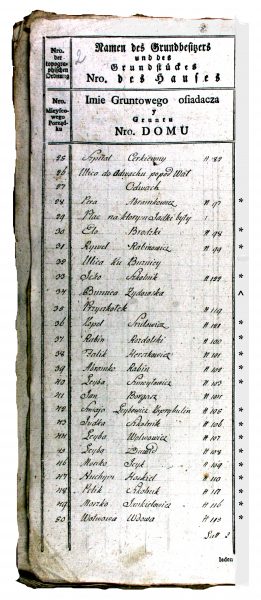The Josephine Survey
The first land and real estate survey was ordered by Emperor Joseph II in 1785 (hence, it is sometimes referred to as the Josephine cadastre or Józefińska metryka).
 During the 1785–1788 survey, population data were collected just before the implementation of the imperial edict, which mandated adoption of the hereditary surnames by the Jews of Galicia (issued in 1787). Hence, male names are almost invariably recorded in a traditional patronymic format (e.g., Moszko Jankielowicz, meaning Moszko, the son of Jankiel), often written with variable spelling. The survey also lists few women, namely the widows with their deceased husbands’ names (e.g., Wolf’s widow or Leib’s widow).
During the 1785–1788 survey, population data were collected just before the implementation of the imperial edict, which mandated adoption of the hereditary surnames by the Jews of Galicia (issued in 1787). Hence, male names are almost invariably recorded in a traditional patronymic format (e.g., Moszko Jankielowicz, meaning Moszko, the son of Jankiel), often written with variable spelling. The survey also lists few women, namely the widows with their deceased husbands’ names (e.g., Wolf’s widow or Leib’s widow).
There are three parts of the survey for every town and village. The first — and most important to the genealogists — contains listings of local houses and the names of each family head. The second includes a description of the boundaries of a town or a village and the types of land (in Polish and in German). The borders were marked and certified under a special oath. The third provides the summary of agricultural outputs recorded for the purpose of taxation (in German).
On occasion, the entries reveal other secrets. The newcomers’ given names are sometimes followed by the name of a town where they came from. For example, in one the data-rich survey from 1787, we can encounter Elo Brodzki (meaning Elo from Brody), Oron Lwowski (meaning Oron from Lwów), or Szlomo Halicki (meaning Szlomo from Halicz, another nearby Galician town). There is even one “Litvak.”
Additional entries, if noted in the records, provide valuable information on the profession of the name bearer. Those often found are glazer, tailor, tavern owner, or wagon driver. Major buildings are often recorded, such as town hall, churches, the market place, and manor houses. For Jewish genealogists, in particular, the discoveries of Jewish schools, synagogues, kahal buildings, and Jewish cemeteries provide the opportunity for a better understanding of the entire neighborhood.
| Above: Page from the Josephine survey (Stanisławów). In 1787 Jewish patronymic names were in daily use (*); the house numbers are recorded to the right of the names. Other entries identify the town’s landmarks, including the synagogue (^). Note: *, ^ added for clarity. |
The Franciscan Survey: click here.
The J&F Project page: click here.
For more details refer to articles: “Early Galician Population Surveys,” Galitzianer, March 2016 and “Research Project Updates,” Galitzianer, September 2017.
